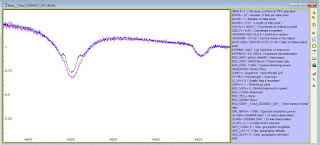There is a gap in BeSS in
march/april but recent spectra from Valérie Desnoux show that it's
back into absorption now.
Here are the graphs with BeSS spectra as of today - again, many thanks to
all active observers of this star!

As it is doing an outburst rather
frequently in the past few years, it is certainly very interesting
to start monitoring it again for this new observing season.
From Coralie Neiner on Spectro-L discussion group:
Noel Richardson has used the BeSS data of V442 And to derive an ephemeris of its emission level. This star seems to be one of the few Be stars for which the outbursts are quite regular.
His model predicts that the next emission maxima should occur on July 13 (2020), January 9 (2021), and September 20 (2021) within an error of a few days.
Each outburst lasts several weeks, so it would be ideal to start observing this target about 1 month before the above dates and continue until emission has decreased (i.e. another 1 month after emission maximum).
So please, consider observing V442 And starting on June 13 (or as soon as your site permits its observations after that date), once per night and until mid-August, and upload your data in BeSS. This will allow us to confirm the validity of the ephemeris and the periodicity of the outbursts.
So critical observing periods should be:
- June 13th, 2020 to August 14th, 2020
- December 9th, 2020 to February 9th, 2021
- August 20th, 2021 to October 20th, 2021
And individual graphs for recent V442 And outburst:






































